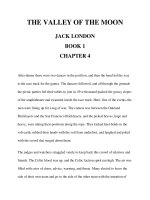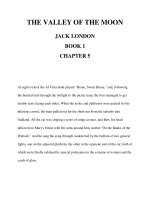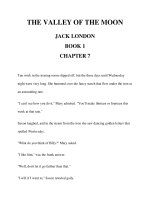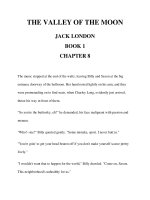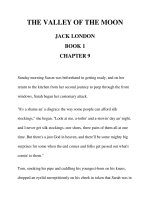science matters the moon
Bạn đang xem bản rút gọn của tài liệu. Xem và tải ngay bản đầy đủ của tài liệu tại đây (5.04 MB, 23 trang )
Contents
Studying the Moon
The Creation of the Moon 6
The Moon's Surface 8
On the Moon 10
Solar System Map 12
Walking on the Moon 14
Gravity's Pull 16
Moon Phases 18
Surfing Our Solar System 20
Science in Action 21
What
Have You
Learned? 22
Words to Know/Index 24
Studying the Moon
"Moon" is not only the name of Earth's nearest
neighbor. It is also the name of any large object in
space that circles a planet. This circular path is called
an orbit.
Many planets have moons, and most planets have more
than one moon. Earth has only one moon. The Moon is
the only place in space where humans have ever landed.
• The full Moon is the second-brightest object in the sky
as seen from
Earth.
Only the Sun is brighter.
Moon Facts
Did you know that the Moon causes Earth's ocean
tides? There are many other interesting facts about
the Moon.
The Moon is about 239,000 miles (384,633 km) away
from Earth.
Í
The Moon is gray in color.
The diameter ofthe Moon is about 2,160 miles
(3,476 km).
The Moon orbits Earth about every 27 days.
The Moon's temperature is always changing.The Moon
can be as cold as -280° Fahrenheit
(-173^)
at night.
Moon days can reach 260° Fahrenheit (127T).
The first unmanned landing on the Moon took place
in 1959.
I
M
I
Twelve people have landed on the Moon between
1969 and 1972.
The Creation
of the Moon
The surface of the Moon is mostly made up of a type
of rock called basalt. Many scientists believe that a rock
called an asteroid struck Earth billions of years ago.
They think that the asteroid chipped a large chunk off
Earth. This piece of rock began to spin around Earth.
It became the Moon that humans see glowing in
the sky.
• Scientists study Moon rocks.They have learned that
the Moon is about 4.5 billion years old.
Moon Movement
The Moon has a special way of moving in the solar
system.
Read on to find out more about how the
Moon moves.
The Moon orbits
Earth,
and
Earth orbits the
Sun.
A
force
called gravity keeps the Moon
in its orbit around Earth. It
takes the Moon about 27 days
to complete one full orbit
around Earth.The same part
of the Moon always faces
Earth.
Humans must fly in
spacecrafts to the Moon
to seethe hidden part.
The Moon's Surface
Dark spots can be seen on the Moon on a moonlit
night. The dark spots are low, flat areas called maria.
Maria means "seas" in Latin. Brighter areas are called
highlands. They are rugged mountains and plains.
Round holes dot the Moon. They are called craters.
Craters are formed when asteroids crash into the
Moon's surface.
^^Qftií.^,.,,.
.
There are more than 3 trillion craters on the Moon.
Moon Time
Did you know that all calendars are not the same?
The calendar that is used every day is based on the
SuruThere is also a calendar based on the Moon.
A year on our calendar lasts 365 days.This is how long
it takes Earth to orbit the Sun.
Still,
this is not the only
calendar that exists. Some people use a lunar calendar.
It is based on the phases of the Moon. A lunar year
has 354 days.Twelve lunar months make a lunar year.
The Muslim and Jewish religions use lunar calendars.
The lunar calendar is also used to mark the dates of
Chinese festivals and holidays. For instance, the Chinese
New Year follows the lunar calendar.
On the Moon
There is no air on the Moon. Sound needs air to
travel. This means that there is also no sound on the
Moon. If a person shouted on the Moon, there would
be no noise.
The temperature on the Moon is very hot during the
day. The Moon is extremely cold at night. The Moon
does not have wind or rain because there is no air or
water. Wind is moving air, and rain is falling water.
• Most astronomers believe the Moon has no water.
Still,
some think the Moon's north and south poles have ice.
r
A Moonlight Experiment
Did you know that the Moon does not create its own
light? Try this experiment to discover why the Moon
can be seen from Earth.
The Moon appears to glow
because it reflects the light of
the
Sun.
Sunlight shines onto the
surface of the Moon and is bounced
off
The
Moon's glow is actually
caused by sunlight.
Learn about reflection using a
flashlight.
You
will need a partner
for this experiment. First, find a dark
room.
Next, shine a flashlight onto
your partner's face. Do you notice
how the light shines off your
partner's face? It is reflecting the
light from the flashlight.This is how
the Moon reflects the Sun's light.
i
fi *
Solar System Map
Match each planet on the left to Its orbit in
the
diagram.
This
will show you the order
of the planets in our solar system.
Mercuiff
Venus
Earth
Mars
Jupiter
Uranus
Neptunei
Pluto
the Moon
14
Astronauts Neil Armstrong and Buzz Aldrin landed
on the Moon on July 20, 1969. They flew to the Moon
on board the
Apollo
i
7.
They took photographs of the
Moon's surface. Before the astronauts left, they placed
a sign that read, "We Came in Peace for all Mankind."
Rocks and bags of soil were brought back to Earth.
• Buzz Aldrin stepped onto the Moon 20 minutes after
Neil Armstrong's first step. Buzz collected rock samples.
The First Step
Neil Armstrong was the first person to walk on the
Moon.
Many more voyages to the Moon have been
made since that first visit.
Neil Armstrong traveled to
the Moon on board the
Apollo
11,
a
spaceship. Neil
carried a camera to record
his first steps on the Moon.
Many people watched him
on television. During his
moonwalk, Neil Armstrong
said:
"That's one small step
for
man,
one giant leap
for mankind."
Gravity's Pull
Earth's gravity is six times stronger than the Moon's
gravity. This means that the Moon's gravity has less
force, or pull, than the Earth's gravity. People are much
lighter on the Moon than they are on Earth. Spacesuits
are also lighter. A 220-pound (100 kg) spacesuit weighs
about 36 pounds (16 kg) on the Moon.
• Astronauts can jump
very high and leap very
far on the Moon.
A Gravity Experiment
Become an astronaut for a day.This activity will
show you how the Moon's gravity feels.
The Moon's gravity is much
weaker than Earth's.This fun
experiment will show you how
light objects feel on the Moon.
You will need:
• two
1-gallon
(3.8
L)
jugs
• a measuring cup
• water
Fill one jug up to the top
with water.Tighten the
lid.
Next, measure 2.5 cups
(591 mL) of water. Pour the
water into the second jug
and tighten the lid.
Go outside to an open
area.Throw the first jug as
far as possible. Next throw the
second jug.The lighter jug should travel much
farther.This is how Moon gravity affects astronauts.
y
i
ïri
Moon Phases
The Sun shines on different parts ofthe Moon as
the Moon orbits Earth. Sometimes, the far side of the
Moon is lit, and the side closest to Earth is dark. This
is called a new Moon. The sky is very dark during
a new Moon.
The Moon and Earth are always moving. This means
that the Sun shines on a different part ofthe Moon
every night. The changes in the way the Moon appears
from Earth are called Moon phases.
^ Phases ofthe Moon ^
Waxing Crescent
First Quarter
Waning Gibbous
Last Quarter
Waxing Gibbous
Waning Crescent
• The Moon goes through eight phases. It takes more
than 29 days for the Moon to go through all ofthe phases.
A Moon Story
The Inuit people tell a story about the Moon. Their
Moon god is named ^nn/ngan. Their Sun goddess
is called Malina.
Anningan likes to chase
his sister, Malina, in circles.
Sometimes, Anningan is
so busy chasing Malina
that he forgets to eat.
When this happens, he
becomes a crescent
Moon.
Anningan goes
away for a moment to eat.
He becomes a new Moon
while he is gone. Soon,
Anningan begins to get fatter
and rounder. He is called a full
Moon when he is completely round.
Anningan never stops chasing Malina.The story
is meant to explain why the phases of the Moon
repeat forever.
Surfing Our
Solar System
How can I find more information
about space?
• Libraries have many interesting
books about space.
• Science centers are great places
to learn about space.
•The Internet offers some great
Web sites dedicated to space.
Where can I find a good reference
Web site to learn more about space?
Encarta Homepage
www.encarta.com
•Type any space-related term into the search engine.
Some terms to try include "asteroid " and "galaxy."
How can I find out more about space, rockets, and astronauts?
NASA Kids
•This Web site offers puzzles and games,along with the
latest news on NASA's research.
Science in Action
Moon Tale
Make up your own story about the Moon. Give the Moon a
different name. Explain in your story why the Moon seems
to be following the Sun.
Create a Moon Calendar
Find an empty calendar with large
squares.
Watch the Moon
and record the shape it takes for 30 days. Each night,
draw the shape of the Moon on the calendar.
It may seem like
the Moon's shape
is not changing
at first.
Soon,
you
will see that the
Moon's shape has
changed.
You
will
have drawn all of
the Moon's phases
by the end
ofthe month.
1
New
Moon
8
15
22
29
Waning
Crescent
First
Quarter
16
23
30
10
17
Full
Moon
24
31
Waxing
Crescent
11
18
25
Last
Quarter
12
19
26
13
Waxing
GibbcLis
20
27
14
21
Waning
Gibbous
I
28
What Have
You
Learned?
Is Earth
the only
planet
with a
|\Aoon?
What
color is
the Moon?
What do we call
the different
shapes of the
Moon as seen
from Earth?
I
Can all
parts of
the Moon
be seen
from Earth?
Does the
Moon make
its own light?
m
^r-
Who were the
first humans
to walk on
the Moon?
Is the gravity on
the Moon the same
force as the gravity
on Earth?
f/a//the
Moon? What do
How many days
are there in a
lunar calendar?
pue
uoo|/\j
x|s
uupiv zzng pue
uo 8J0UJ
s\
uns
•o|\j '
uooi/\(
uoo|/\|
aqip apjs auo
A|uo
'ON
> saseqd '£
•uooui auo ueq; ajouj
isoi/\|
"
U
Do humans
weigh more
on the Moon
or on Earth?
Words to Know
asteroid:
a
small,
solid object in
space that circles the Sun
astronomers: people who study
space and its objects
basalt: a hard rock formed in very
hot conditions
diameter: the measurement of
a
straight line passing through
the center of
a
circle
gravity:
a
force that pulls things
toward the center
lunar: related to the Moon
orbit: the circular path a planet
makes around an object in
the sky, such as the Sun
phases: the appearance of tie
Moon from Earth
reflects:
throws or bends light back
Index
air 10
Aldrin,
Buzz 14
Apollo n 14,15
Armstrong, Neil
14,15
asteroids 6,8,12,20
astronauts 14,17,20
basalt 6
craters 8
Earth 4,5,6,7,9,11,13, phases 9,18,19,21
14,16,17,18 planets 4 L
gravity
7,16,17
lunar calendar 9
Moon rocks 6,14
orbits 4,5,7,9,18
reflection 11
Sun 4,7,9,11,13,18,
19,21
surface 8,14
temperature 5,10




